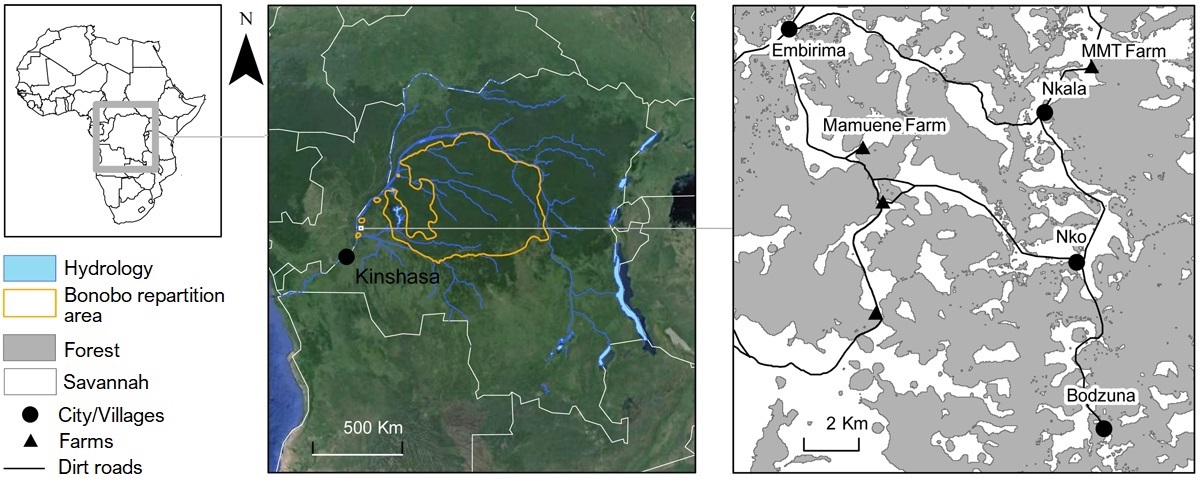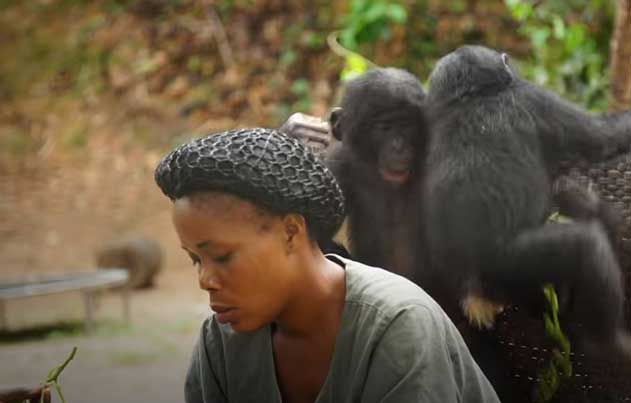Meet Bonobo ECO
> Bonobo ECO (for Étude & COnservation (Study & COnservation)) is a non-profit organisation created in 2008 under the 1901 French Law of Association that focuses on the research and conservation of bonobos (Pan paniscus) in the wild. The association strongly believes that the conservation of bonobos can only be achieved in close partnership with the human populations that live alongside these primates, which is why it has joined forces with M'bou-Mon Tour and its now 20-year-old community-based bonobo conservation project.
The Bonobo Eco Project
At the heart of what they do
Victor NARAT, CNRS Research Fellow, Eco-anthropology, Musée de l'Homme, Paris, France.
 Context and objectives
Context and objectives
> Understanding the state of isolation of the Southwestern bonobo sub-population.
Isolation increases the risk of genetic drift and inbreeding, so in order to be able to best adapt conservation strategies, it is essential to have a comprehensive understanding of the state of isolation of this sub-population.
The Bonobo ECO Story
 History
History
> Victor Narat, founder and current president of Bonobo ECO, has been passionate about the study and conservation of great apes ─ and bonobos in particular ─ for over 15 years. A vet by training, he has developed, in parallel with his activities in the non-profit field, a long-term research project aimed at better understanding the ecology, behaviour, sociability, and health of bonobos in the M’bou Mon Tour conservation area.
> Having completed his thesis on human-bonobo-habitat interactions at the Muséum National d'Histoire Naturelle (National Museum of Natural History, Paris, France), Narat joined the CNRS in France as a researcher where he studied, in particular, the relationship between humans and great apes. The funds allocated to scientific research in this context do not allow for the maintenance of a long-term research site, hence the importance of using other funding channels to continue his both basic and applied research project, which is essential if we are to better understand and better protect bonobos.
 Missions
Missions
> Bonobo ECO supports two main types of activity
- Public awareness
In order to raise public awareness and, ultimately, change the conversation around the conservation of great apes, we lead conferences, have stands at events, make appearances in the media, and more. Using our research as a base, we seeks to demonstrate how humans and apes can coexist and show that the permanent exclusion of humans from protected areas is often counterproductive. - Supporting scientific fieldwork
In order to be able to better protect bonobos, it is essential to better understand them, their environment, and their relationship with humans. This is why, since 2010, Bonobo ECO has been supporting Victor Narat’s long-term research project in collaboration with MMT. The project started with the habituation of the Manzano bonobo community near the village of Embirima (see map).
 Perspectives
Perspectives
> The process of habituating bonobos to observers takes about four years of daily effort. Once the bonobos are accustomed to human presence, it’s essential to maintain that human presence and develop the observations made, hence the importance here of scientific research. We have trained two local scientific assistants who collect data on a daily basis in order to study: the bonobos’ diet; the way they use the available habitat; their reactions to humans; their sociability; their health; etc. This data collection work is laborious but it’s essential if we are to better understand and better protect the bonobos of this area, along with the species in general. The work also requires regular resources, which can be difficult to obtain from traditional donors.
> The project has already resulted in six scientific papers in international journals on subjects including the health of bonobos in the area, their relationships with humans, how they use the habitat, and the characterisation of the habitat. Furthermore, the area’s environment is a forest-savannah mosaic, which is a rarely encountered bonobo habitat. Thus, this scientific project allows us to better understand how bonobos live in this fragmented habitat and to formulate recommendations at the local level for their conservation. It also allows us to better understand the species in general ─ for example its capacity to adapt ─ which is essential if we are to better orient conservation strategies at the species level.
Victor. NARAT
President of Bonobo ECO



